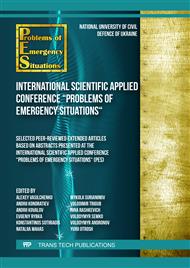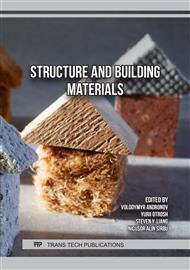[1]
R.R. Khasanshin, R.R. Safin, E.Y. Razumov, High Temperature Treatment of Birch Plywood in the Sparse Environment for the Creation of a Waterproof Construction Veneer, International Conference on Industrial Engineering, Procedia Engineering. 150 (2016) 1541-1546
DOI: 10.1016/j.proeng.2016.07.108
Google Scholar
[2]
R.F. Mendes, G.B. Junior, N.F. Almeida, P.G. Surbi, I.N. Barbeiro, Effect of thermal treatment on properties of OSB panels, Wood Sci Technol. 47 (2013) 243-256
DOI: 10.1007/s00226-012-0494-7
Google Scholar
[3]
R.R. Safin, R.R. Khasanshin, A.R. Shaikhutdinova, R.R. Ziatdinov, The technology for creating of decorative plywood with low formaldehyde emission, IOPConf. Series: Materials Science and Engineering. 93 (2015) 012077
DOI: 10.1088/1757-899X/93/1/012077
Google Scholar
[4]
Yu.V. Tsapko, O.P. Bondarenko, O.Yu. Horbachova, S.M. Mazurchuk, Research of the process of water absorption by thermally modified wood, IOP Conference Series: Materials Science and Engineering. 1164 (2021) 012030
DOI: 10.1088/1757-899X/1164/1/012030
Google Scholar
[5]
Yu.V. Tsapko, O.Yu. Horbachova, А.Yu. Tsapko, S.M. Mazurchuk, D.L. Zavialov, N.V. Buiskykh, Establishing regularities in the propagation of phase transformation front during timber thermal modification, Eastern-European Journal of Enterprise Technologies. 1/10 (109) (2021) 30-36
DOI: 10.15587/1729-4061.2021.225310
Google Scholar
[6]
N. Ayrilmis, S. Jarusombuti, P. Bauchongkol, Effect of thermal-treatment of wood fibres on properties of flat-pressed wood plastic composites, Polym Degrad Stabil. 96 (2011) 818-822
DOI: 10.1016/j.polymdegradstab.2011.02.005
Google Scholar
[7]
A. Lovrić, V. Zdravković, R. Popadić, G. Milić, Properties of Plywood Boards Composed of Thermally Modified and Non-modified Poplar Veneer, BioResources. 12 (4) (2017) 8581-8594.
DOI: 10.15376/biores.12.4.8581-8594
Google Scholar
[8]
M.J. Boonstra, A. Pizzi, F. Zomers, M. Ohlmeyer, W. Paul, The effects of a two stage heat treatment process on the properties of particleboard, HolzalsRoh- und Werkstoff. 64 (2) (2006) 157-164
DOI: 10.1007/s00107-005-0055-y
Google Scholar
[9]
W. Paul, M. Ohlmeyer, H. Leithoff, Thermal modification of OSB-strands by a one-step heat pretreatment-Influence of temperature on weight loss, hygroscopicity and improved fungal resistance, Holz als Roh- und Werkstoff. 65 (1) (2007) 57-63
DOI: 10.1007/s00107-006-0146-4
Google Scholar
[10]
M. Nazerian, M.D. Ghalehno, A.B. Kashkooli, Effect of wood species, amount of juvenile wood and heat treatment on mechanical and physical properties of laminated veneer lumber, Journal of Applied Sciences. 11 (6) (2011) 980-987
DOI: 10.3923/jas.2011.980.987
Google Scholar
[11]
G. Goli, C. Cremonini, F. Negro, R. Zanuttini, M. Fioravanti, Physical-mechanical properties and bonding quality of heat treated poplar (I-214 clone) and ceiba plywood, iForest – Biogeosciences and Forestry. 8 (1) (2014) 687-692
DOI: 10.3832/ifor1276-007
Google Scholar
[12]
J. Huang, K. Li, A new soy flour-based adhesive for making interior type II plywood, Journal of the American Oil Chemists' Society. 85 (2008) 63-70
DOI: 10.1007/s11746-007-1162-1
Google Scholar
[13]
S.I. Tohmura, G.Y. Li, T.F. Qin, Preparation and characterization of wood polyalcohol-based isocyanate adhesives, Journal of Applied Polymer Science. 98 (2005) 791-795
DOI: 10.1002/app.22072
Google Scholar
[14]
K. Umemura, A. Takahashi, S. Kawal, Durability of isocyanate resin adhesives for wood. II. Effect of the addition of several polyols on the thermal properties, Journal of Applied Polymer Science. 74 (1999) 7-14. doi: 10.1002/(SICI)1097-4628(19991114)74:7<1807::AID-APP24>3.0.CO;2-0
DOI: 10.1002/(sici)1097-4628(19991114)74:7<1807::aid-app24>3.0.co;2-0
Google Scholar
[15]
H. Kishi, A. Fujita, H. Miyazaki, S. Matsuda, A. Murakami, Synthesis of wood-based epoxy resins and their mechanical and adhesive properties, Journal of Applied Polymer Science. 102 (2006) 85-92
DOI: 10.1002/app.24433
Google Scholar
[16]
S. Sowunmi, R.O. Ebewele, A.H. Conner, B.H. River, Fortified mangrove tannin- based plywood adhesive, Journal of Applied Polymer Science. 62 (1996) 577-584. doi: 10.1002/(SICI)1097-4628(19961017)62:3<577::AID-APP15>3.0.CO;2-W
DOI: 10.1002/(sici)1097-4628(19961017)62:3<577::aid-app15>3.0.co;2-w
Google Scholar
[17]
Y.J. Liu, K. Li, Development and characterization of adhesives from soy protein for bonding wood, International Journal of Adhesion & Adhesives. 27 (1) (2007) 59-67
DOI: 10.1016/j.ijadhadh.2005.12.004
Google Scholar
[18]
M. Šernek, M. Boonstra, A. Pizzi, A. Despres, P. G´erardin, Bonding performance of heat treated wood with structural adhesives, Holz als Roh- und Werkstoff. 66 (3) (2008) 173-180
DOI: 10.1007/s00107-007-0218-0
Google Scholar
[19]
A. Pizzi, K.L. Mittal, Melamine–Formaldehyde adhesives in: Handbook of Adhesive Technology, Marcel Dekker, Inc., New York, NY. (2003)
DOI: 10.1201/9780203912225.ch32
Google Scholar
[20]
D. Vnučec, M. Mikuljan, A. Kutnar, M. Sernek, Influence of process parameters on the bonding performance of wood adhesive based on thermally modified soy proteins, European Journal of Wood and Wood Products. 74 (4) (2016) 553-561
DOI: 10.1007/s00107-016-1018-1
Google Scholar
[21]
BS EN 204:2016 Classification of thermoplastic wood adhesines for non-structural applications.
Google Scholar
[22]
DIN EN Adhesives – Wood adhesives for non-structural applications – Determination of tensile shear strength of lap joints.
DOI: 10.3403/30315353u
Google Scholar
[23]
EN 310:1993 Wood-based panels – Determination of modulus of elasticity in bending and of bending strength.
DOI: 10.3403/00299457
Google Scholar
[24]
EN 314-1:1993 Plywood – Bonding quality – Part 1: Test methods.
Google Scholar
[25]
EN 314-2:1993 Plywood – Bond quality – Requirements.
Google Scholar
[26]
Yu. Tsapko, O. Horbachova, S. Mazurchuk, O. Bondarenko, Specific Aspects of the Study of the Surface Properties of Plywood, Materials Science Forum. 1066 (2022) 175-182.
DOI: 10.4028/p-b15jpx
Google Scholar



